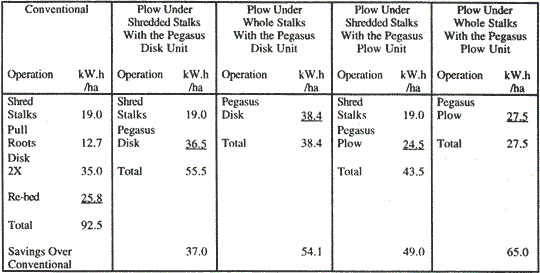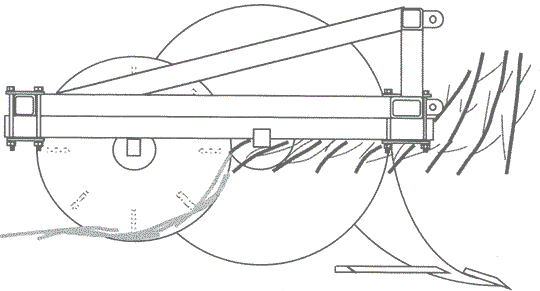Tillage Energy Savings From Zone Burial of Shredded and Whole Cotton Stalks
Lyle Carter, Joe Chesson, Gary Thacker, and Vic Penner
Abstract
Two prototypes of a stalk burial implement were tested for energy requirements at the University of California, Shafter Research Station. Both versions of the implement are designed to bury the cotton stalks in a concentrated zone and reform the bed in the same location. To plow under shredded stalks, both versions of the implement required less energy than a conventional tillage systems typical of the San Joaquin Valley of California. Both stalk burial implements were also used to plow under whole cotton stalks. This offers additional energy savings by eliminating the stalk shredding operation.
Introduction
Many cotton growing states mandate cotton "plow down" as a means of controlling the pink bollworm and/or boll weevil. Regulations vary from state to state, and generally require that the tap root be loosened and the crop residue buried.
Present farmer practices require many field operations {Table 2) in order to prepare a harvested cotton field for the next spring's planting. All of these operations, except the re-bedding must be performed in a timely manner in order to meet the state plow down requirements. Farmers often have trouble meeting these deadlines because of inclement weather, late harvest, and available equipment and personnel. Present practices also preclude the use of precision tillage in which beds are maintained in the same location for successive years.
This test is part of a larger study on the fate of soil organic matter and humus in cotton production. This paper reports on the energy requirements of tillage systems used in the study.
One of the tillage techniques used in this study is to zone bury whole cotton stalks in a one-pass operation. A preliminary study in 1994-95 at the Shafter Research Station indicated that whole cotton stalks, when buried in a concentrated zone in the soil, decompose more slowly than shredded cotton stalks. This work was done with a trencher and by inserting the stalks by hand into the trench. There were no disease or agronomic problems associated with whole stalk burial.
Materials and Methods
The test field is located at the Shafter Research Station. The plots are set out in a randomized split plot with repeated measure design. The treatments were: stalks standing, stalks shredded, irrigated after harvest (to simulate wet weather conditions), and non-irrigated after harvest. Test plots were approximately 55 feet long. The field was divided into four replications with four runs per treatment.
Two types of stalk burial implements were evaluated: the Pegasus "disk" unit consisted of two 50-inch diameter disk blades (Figure 1). The other unit, referred to as the Pegasus "plow", uses narrow moldboard type plows rather than the two disks. Both units operate in a similar manner, in which a deep slot is formed adjacent to the crop row, then the stalks are folded and placed into the slot with a "stuffer disk". As the machine moves forward, soil falls into the slot and covers the stalks. Disk bedders were mounted on the rear of each unit re-form the beds in the original location. Each stalk burial implement is three-point hitch mounted. We mounted each to an instrumented three-point hitch tool bar for draft measurements.
Two-row prototype equipment was used for these tests. Commercial units will be four-row and six-row implements.
The conventional tillage treatment in this study represents a typical tillage system used by farmers in the San Joaquin Valley. First, the stalks were shredded with a Dandl flail shredder. The tap roots were then pulled with a Sundance root puller. A disk harrow was used twice to incorporate the crop residue into the soil. The plan was to re-bed after the second disking.
Energy data from the Pegasus implements were analyzed with a general linear model on the SAS System. We did not have the instrumentation required to measure drawbar draft and PTO power used in the conventional tillage treatment, therefore we used published data to construct the energy used in the conventional operations (Table 2). These values may be conservative because: 1) only necessary operations at the test site were performed (farmers may use more operations depending on soil condition, etc.); 2) proper size tractors were assumed (farmers often use an available larger tractor).
Results and Discussion
The non-irrigated test plots were not included in this study because of dry soil conditions. Record high temperatures in the fall caused the cotton plants to continue pulling moisture out of the soil until they were shredded and/or plowed under. This, together with a lack of rain combined to make the soil extraordinarily hard and dry .The disk unit had difficulty in penetrating the soil to both open a slot and to have sufficient soil to re-form the beds. The plow unit was able to penetrate the soil and form a suitable slot, but the clods were very large and difficult to re-form into beds. The draft requirements of both Pegasus units was so high in the dry soil that in some cases the tractor had insufficient power. Also, because of the large draft requirements there was a high probability of damaging the instrumented three-point hitch tool bar .
Both Pegasus units operated satisfactorily in the irrigated plots. With adequate soil moisture, both stalk burial implements did an excellent job of burying the stalks in the slot located near the centers of the bed. The disk bedders did an excellent job of re-forming the beds in their original location. There were some problems of the operator being able to maintain the proper alignment of the implement to the beds. In these cases, the stalks were either missed and/or were not covered properly in the slot. These implements are long and sensitive to three-point hitch leveling. The Pegasus is a highly "directional" implement, with a pronounced tendency to travel in the direction it is pointed, hence three-point hitch alignment is also critical. On four-row and six-row Pegasus units, the alignment problems have been solved with the use of an articulated quick hitch guidance system.
The energy requirements of the Pegasus units are shown in Table 1. The disk unit required significantly more energy than the plow unit (t = 10.34512, P = 0.0001). The higher energy requirement for the disk unit can be partially attributed to two things. First, a ripper is mounted on the front of the disk unit to facilitate the penetration of the large disk blades (Figure 1). Second, we had some difficulty maintaining constant operating depths, this tended to make the disk bedders move more soil than those on the plow unit. The coefficient of variation for the disk unit (15.4%) was nearly double that of the plow unit (8.2%). We attribute this larger variation to our difficulties in maintaining a constant operating depth with the disk unit; this affected the volume of soil moved by the disk bedders. We did note some isolated high energy values for the disk unit which resulted from instances when the unit ran too deep, therefore the mean energy values may be overstating the expected energy performance of the unit.
Both Pegasus units required slightly more energy to plow under whole stalks than unshredded stalks, although at a probability level above 0.05 the difference would generally be classified as a trend (t = 2.11113, P = 0.0772).
The conventional tillage treatment, following shredding, root pulling and two disking operations, was not rebedded at the time of this article awaiting spring rains.
A comparison of energy inputs indicates that either one of the Pegasus units will result in a energy savings over conventional tillage (Table 2). To plow under shredded stalks, the disk and plow units can save 37.0 kW .h/ha and 49.0 kW.h/ha over conventional tillage, respectively. To plow under whole stalks, the shredding operation is eliminated and the energy savings are 54.1 kW .h/ha for the disk unit and 65.0 kW ./ha for the plow unit.
Acknowledgments
This work was funded in part by a grant from the U .S. Department of Energy's Energy-Related Inventions Program. This work is a part of a Cooperative Research and Development Agreement between USDA, ARS, Shafter CA and Pegasus Machinery Company, Tucson, AZ.
Figure 1. Side schematic view of the Pegasus disk unit plowing under whole cotton stalks. This invention is fully described in U.S. Patent No. 5,285,854.
Table 1. Energy requirements of the Pegasus disk and plow units at the Shafter Research Station. Data taken 17 November 1995.
|
Pegasus Unit
|
Field Preparation
|
Energy, kW.h/ha*
|
|---|---|---|
|
Disk
|
Standing Stalks
|
38.4
|
|
Disk
|
Shredded Stalks
|
36.5
|
|
Plow
|
Standing Stalks
|
27.5
|
|
Plow
|
Shredded
|
24.5
|
Table 2. Comparison of energy requirements with conventional tillage, burying shredded and whole stalks, with the Pegasus disk and plow units at the Shafter Research Station.

Issued in furtherance of Cooperative Extension work, acts of May 8 and June 30, 1914, in cooperation with the U.S. Department of Agriculture, James A. Christenson, Director Cooperative Extension, College of Agriculture and Life Sciences, The University of Arizona.
The University of Arizona is an equal opportunity, affirmative action institution. The University does not discriminate on the basis of race, color, religion, sex, national origin, age, disability, veteran status, or sexual orientation in its programs and activities.
Any products, services, or organizations that are
mentioned, shown, or indirectly implied in this web document do not imply
endorsement by The University of Arizona.
Information provided by:
College of Agriculture and Life Sciences, The University of Arizona
Crop Mgmt | Soil Mgmt | Irrigation | Varieties | Cotton Comments
Home | Cotton | Advisories
document located at: http://cals.arizona.edu/crops/equipment/zone.html
Copyright © 2001 University of Arizona,
College of Agriculture and Life Sciences
Webmaster: Al Fournier (acis@ag.arizona.edu)
